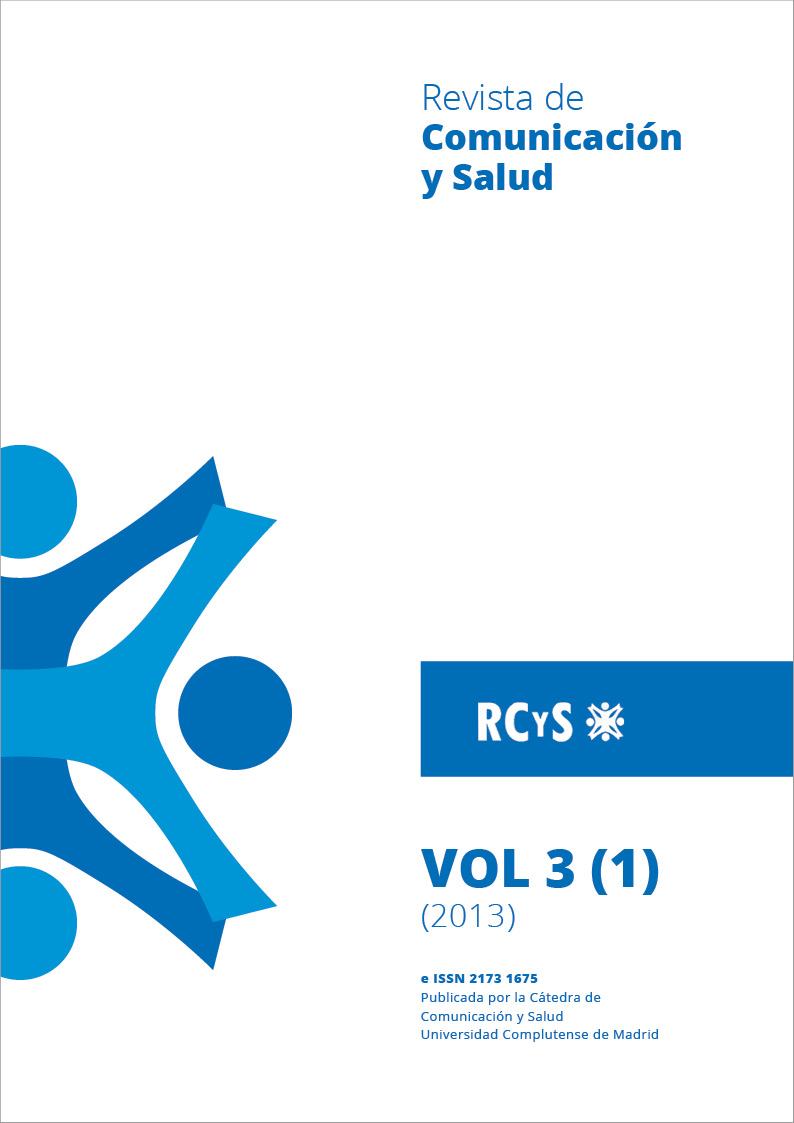The Challenge of Making Communication a Strategic Component of Public Health Policies
DOI:
https://doi.org/10.35669/revistadecomunicacionysalud.2013.3(1).51-65Keywords:
communication; public health; public health policies; guidanceAbstract
This articl e discusses the main components of the project that the Offic e of Public
Info rmation and Co mmun ication of the Argentin e Ministry of Health ha s b een
developing since 2009 to promote communication as one of the strategic aspects of
health policies.
The network of subsystems, jurisdictions, health care levels and participants of health
care policies, programs and services, as well as the diverse issues affecting people’s
health, c ons titute some of the features that exp ress the c om plexity which is
characteristic of the public health field and which pose significant challenges when
carrying out the aforementioned project.
The lack of institutionalization of the Office of Public Information and Communication
of the Argentine Ministry of Health; the absence of a clear definition of the content and
implications regarding the role played by communicational guidance; fragmentation;
the dominant instrumental vision, which equates communication work with designing
prevention campaigns for the media; and the deficiencies in planning and assessing
capabilities were some of the critic al issues identified during the diagnosis made at
the beginning of the process.
Promoting an organizational culture focused on managing information and knowledge,
prioritizing the cultural and communicational aspects of health care issues, as well as
working towards professionalizing and empowering public health communicators and
implementing strategies among disciplines, institutions and sectors aimed at fostering
integration and coordination, are some of our main daily and future goals.
Downloads
References
Briggs, Charles. (2005). Perspectivas críticas de comunicación y hegemonía comunicativa: aperturas progresistas, enlaces letales. Revista Antropología Social. Vol. 14, pp.101-124. Coordinación General de Información Pública y Comunicación (CGIPyC). (2010). Funciones
básicas de información y comunicación en salud pública, Ministerio de Salud de la Nación Argentina. Buenos Aires.
El Ágora. (2006). Comunicación y desarrollo. Aportes para la transformación social. Disponible en http://www.elagora.org. Recuperado el 11 de octubre de 2012.
Fuks, Ana; Jait, Andrea; Harrington, María; Pérez Panelli, Sebastián y Rovere, Mario. (2008). Dossier central migraciones y salud. Revista PoSIbles. Nº 2, pp. 20-30.
Jaramillo López, Juan Camilo. (2004). Modelo de comunicación pública organizacional e informativa para entidades del Estado. Bogotá: MCPOI, USAID/Casals & Associates Inc.
Johns Hopkins Uuniversity. (2002). Estrategia de comunicación para PROSILAIS. Baltimore.
Menéndez, Eduardo. (2006). Interculturalidad, 'diferencias' y Antropología ‘at home'. Algunas cuestiones metodológicas. En Fernández, G. (Coord.). Salud e interculturalidad en América Latina, antropología de la salud y crítica intercultural. Quito: Universidad Castilla-La Mancha/Edit.ABYA AYALA.
Menéndez, Eduardo y Spinelli, Hugo. (Coords.). (2006). Participación social ¿Para qué? Buenos Aires: Editorial Lugar.
OPS-OMS. (1995). Información y comunicación social en salud. Disponible en http://bvsms.saude.gov.b. Recuperado el 11 de octubre de 2012.
OPS/Fundación Kellogg. (2001). Manual de comunicación social para programas de promoción de la salud de los adolescentes. Washington D.C.
Perdiguero, Enrique. (2006). Una reflexión sobre el pluralismo médico. En Fernández, G. (Coord.). Salud e interculturalidad en América Latina, antropología de la salud y crítica intercultural. Quito: Universidad Castilla-La Mancha/Edit.ABYA AYALA.
Waisbord, Silvio. (s/f). Árbol genealógico de teorías, metodologías y estrategias en la comunicación para el desarrollo. Fundación Rockefeller, Mimeo.
Downloads
How to Cite
Issue
Section
License
Disclaimer: As of 2023, RCyS is licensed under the Creative Commons Attribution-NonCommercial 4.0 International License (CC BY-NC 4.0).
Articles from 2011 to 2022 are under a Creative Commons CC BY 4.0 License that allows copying and redistributing the material in any medium or format, remixing, transforming and building upon the material for any purpose, including commercial.
We also inform that RCyS is adhered to the Declaration of Berlin.






